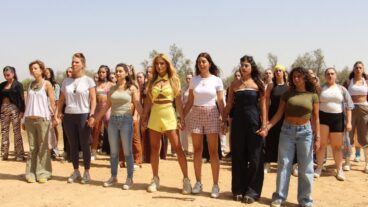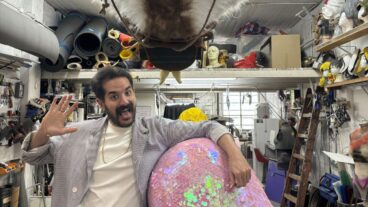‘Word goes out that this is avant garde art that you can’t find anywhere else,’ said Michael Jankelowitz, spokesperson of the Jewish Agency for Israel.From the Israel Museum in Jerusalem to the Museum of the Negev in Beersheva; from the walls of Reverend Al Sharpton’s home in New York to the mantle of photographer Irene Furtik’s home in Santa Monica, Ethiopian Israeli art has arrived.
Award-winning artist Elaine Galen, whose work has been displayed in prestigious venues across America, describes her favorite Ethiopian Israeli piece – a sandy-colored, miniature clay sculpture that sits atop the fireplace in her living room:
“It’s in the likeness of an Ethiopian rabbi. He has a beard, he’s wearing a kippah on his head, and he has a tallit draped down his back… His arms are extended in front: His hands come forward, like two hands in prayer, then suddenly become a unit, turning into a plaque that is a symbol of the Torah…. [H]is head is extending up, with his mouth halfway open – as if he knows the words by heart, as if he’s reciting them. It’s beautiful,” she said.
Galen immediately bought the sculpture for her private art collection, an eclectic mix following her one guiding principle – good taste in art.
“When I saw this piece,” she said, “I saw quality.”
The indigenous, noncommercial feel of the art was especially appealing to Galen, and it is a key ingredient in the growing attraction to Ethiopian Israeli pieces sold throughout Israel and abroad.
“Word goes out that this is avant garde art that you can’t find anywhere else,” said Michael Jankelowitz, spokesperson of the Jewish Agency for Israel. Drawn to its signature style, he said, Israeli tourists hungrily purchase Ethiopian artwork at galleries and stores across the country.
For numerous Ethiopian artists throughout Israel, artwork is their primary source of income. Some work for an hourly wage at a studio; others work independently from their homes.
One independent artist, who prefers to remain anonymous, has created a well-known line of biblical paintings with all-black figures – from Noah and Moses to Devorah and Miriam. In this way, his art parallels much African American religious art, challenging European-based images of religious history.
The bold colors of his paintings – yellow, green, red, orange and blue – also can be found in the embroidery of Yazazo Aklum, who has several works housed in the Israel Museum’s collection of Ethiopian art. Ora Shwartz-Be’eri, Israel Museum curator, beams as she holds up one of his pieces.
“It’s exceptional,” she said passionately.
With its vibrant portrayal of the Ten Commandments, two Lions of Judah with Stars of David, and a dove and rainbow from Noah’s arc, the tapestry is indeed breathtaking. For this reason, it was photographed for the 1994 postcard printed in honor of the peace treaty between Israel and Jordan.
Despite the success of Ethiopian Israeli art, Ethiopian Israeli artists are struggling for power and economic leverage in representing their own work. According to Shlomo Akele, director of Bahalachin Cultural Center for Ethiopian Jews, individual artists are disenfranchised, because there is currently no museum, gallery, or center run by a community member.
Tasamach Tazazo, a retired potter and embroidery artist living in Tel Aviv, agrees.
“We have to take this on ourselves,” she said emphatically, “and not let other people manage our artwork.” But independence will take time, she adds, being that it is linked to complex social, racial and economic struggles associated with the community’s relatively recent immigration.
“On the one hand, they say we are primitive, even tell us we are not real Jews, and on the other hand they get all excited about our artwork,” she explained. “Not everyone. But there are people who have bought my artwork, even turned around and sold it for up to seven times what they paid, and all the while looked down at me as stupid and worthless.”
In a conversation with Avital Armoni, the owner of Armoni’s Art, Tazazo’s claims ring true. Among its other art products, Armoni’s company makes magnetic prints of Ethiopian Israeli embroideries – a popular and seemingly lucrative sales item. Though her company profits from the work of Ethiopian Israeli artists, Armoni makes a point of asserting that Ethiopian Jews “are not really Jewish.”
In addition to facing battles over their identity, Ethiopian Israeli artists are facing tremendous financial hardships. The Ethiopian community is reportedly the hardest hit by Israel’s economic crisis, and out of desperation for money, many artists tolerate exploitation.
Others turn to Bahalachin for help.
“Our dream is to create a big center in Jerusalem,” Akele said in response to the numerous requests he receives. “There are very many talented artists… we just need the framework to support and develop them.” That framework, he noted sadly, takes the financial resources not coming to Bahalachin during these hard times.
As an upshot, while the artwork of Ethiopian Jews is enjoying financial success and mainstream acceptance, Ethiopian Israeli artists are struggling for respectful recognition, economic empowerment and self-representation. Ironic though it may seem, art has always been ahead of its time.
(Originally appeared in The Jewish Journal)












